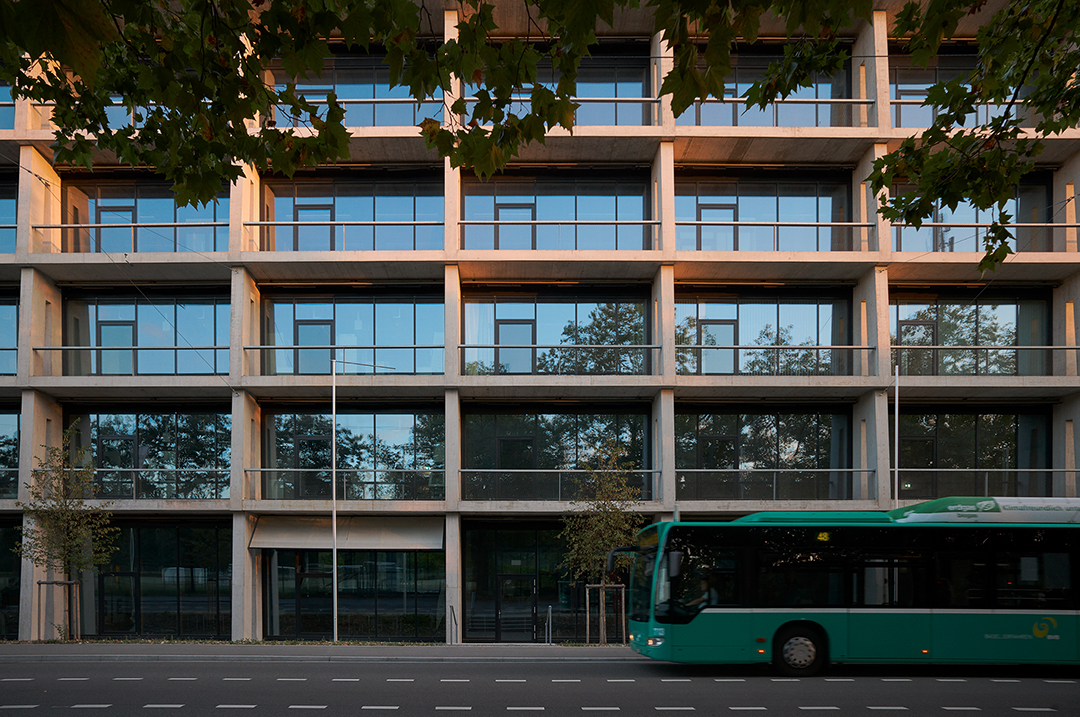

设计单位 Herzog & de Meuron
项目地点 瑞士阿尔施维尔市
建成时间 2023年
建筑面积 40,000平方米
瑞士阿尔施维尔市的西北边缘,与法国直接接壤处,是全球制药、医药和研究领域创新公司的集聚之地。BaseLink基地内,正在开发中的SIP(Switzerland Innovation Park,瑞士创新园)主园区项目为现有的技术和生命科学产业集群增添了新的一员,它毗邻着体育设施、休闲区和住宅区。
The northwest edge of Allschwil, Switzerland, directly adjacent to the border with France, is a global hub for innovative companies in the fields of pharmaceuticals, medicine, and research. The SIP Main Campus project is being developed in this area within the BaseLink site, joining the existing Tech and Life Science Cluster; it is adjacent to sports facilities, a recreational area, and a residential neighborhood.



结构方面,该建筑以尽可能减少内部分隔和垂直支撑为概念,使得空间用途多样化;这种灵活性与建筑材料的耐久性相结合,延长了建筑可能的使用寿命。项目的潜在用户是来自生物技术和医疗保健行业的初创企业、扩张中的企业和成熟公司,还包括一些有助于更好地平衡工作与生活,以及整体振兴该地区的项目。例如,瑞士国际学校将在此开设一所小学,这将有助于最大限度地减少家庭的额外通勤需求。
The structural concept reduces interior divisions and vertical supports as much as possible, allowing for a large variety of uses; this flexibility, combined with the durability of building materials, extends the potential life span of the building. Start-ups, scale-ups, and established companies from the biotech and healthcare sectors are addressed as potential users, as are programs that contribute to a better work-life balance and the overall revitalization of the area – for example, the Swiss International School will open a primary school, which will help minimize the need for additional commuting for families.

SIP主园区的设计基于“庭院房屋”的概念,提供了大约5万平方米的可用建筑面积,可容纳2500—3000名员工,因此是基地中最大的建筑。景观庭院可以通过一对两层通高的通道进入,通道与街道高度平齐,穿过建筑体量。一系列绿色空间从西到东贯穿整个BaseLink基地,而此处通道恰为其中之一。这些绿色空间有助于形成良好的小气候,并得以将不同权属的地块连接在一起。
Based on the concept of a "courtyard house", the SIP Main Campus offers approx. 50,000 m² of usable floor area for 2500-3000 employees and thus is the largest building on the site. The landscaped courtyard is accessible through a pair of two-storey passages that cut through the block at street level. It is one of a sequence of green spaces running from west to east through the entire BaseLink site, contributing to a good microclimate and allowing connections from one property to the next.




园区中央的娱乐区面积和足球场一样大,既种有遮阴的树木,也利用深种植池栽植了较为低矮的植物,使人们视线水平高度的轴线不受遮挡,便于人们辨识方向和路径;攀缘植物将绿色景观竖向延伸到建筑的柱子上。地表面由透水能力强的砾石和渗流坑组成,呼应了该地区原有的河床景观。人们经由内部庭院,通过位于角落的4个尺度巨大的螺旋楼梯进入建筑,每层楼梯可抵达8个不同的用户。
The shaded central recreation area – as large as a football field – is designed with a combination of trees and deep-bed planting, leaving the visual axis at eye level free for easy orientation; climbing plants extend the landscape vertically to the pillars of the building itself. The groundscape consists of largely unsealed gravel surfaces and seepage pits in reference to the original riverbed landscape of the area. From the inner courtyard, the building is accessed via four generously designed spiral staircases in the corners, allowing for up to eight different main users per floor.



立面由一个进深很大的、网格状的混凝土结构定义,它承担垂直荷载,并帮助抵抗风和可能发生的地震的影响。建筑内、外均成环的结构,得以减少建筑内部结构要素的尺寸和数量,从而使得为用户提供的户型和空间规模最大程度地多样化和灵活化。
The facade is defined by a deep, gridlike structure of insitu-concrete, which absorbs vertical loads and serves as bracing for wind and potential earthquakes. These inner and outer rings of structure allow for a reduction of size and number of structural elements inside the building, which in turn offers the greatest possible typological and scale flexibility for users.



内部的空间逻辑让各种交流、逗留和相遇有机会发生,建筑还为人们提供了遮阳系统,日常使用的走廊也兼作消防通道。同时,这些室外空间可以借助立面的遮阳被动冷却以调节温度,在有需要时,能源高效的温度调节系统也会发挥作用。整个BaseLink基地由地热能供能。
The loggias of the inner façades allow for a variety of opportunities for exchange, lingering and encounter. They further provide protection from the sun, along with awnings, as well as access to the building and serve as fire escapes. At the same time, these outdoor spaces allow passive cooling through the shading of the facades, which is supplemented by energy-efficient heating and cooling ceiling panels as needed. The entire BaseLink site is served by geothermal energy.



这个网格的竖向元素有一个轻微倾斜的角度,这将一部分力传导到水平方向,并使得建筑空间更加贴合人类身体尺度。地面层被商业和餐饮空间占据,还有一个可容纳300人的大会堂。由于会堂也可用于举办外部活动,它成为另一个将建筑与社区联系起来的功能元素。地上所有楼层的平面布局、承重网格结构和空间层高都足以容纳实验室或办公空间。
The vertical elements of this grid are at a slight incline. This slight deviation lends weight to the horizontals and integrates the dimensions of the building to a human scale. Businesses and restaurants occupy the ground floor, together with a large auditorium with seating space for up to 300 people. Also available for external events, the auditorium is another program element that connects the building to the community. The floor plan, loadbearing grid, and room height of all five floors can accommodate laboratories or office spaces.




4个开放的楼梯连接着各层环绕着内庭院的阳台,内庭院是整个建筑的焦点,并有助于人们在建筑中掌握自己的位置;楼梯与会堂一起,形成了人们交流和沟通的地方。
The four open staircases connecting the surrounding balconies of the inner courtyard are focal points throughout the building and aid in orientation; together with the auditorium, they form areas of exchange and communication.
巴塞尔艺术家Renée Levi为这些空间设计了一个艺术概念。流动的白色石膏线条形成交错的网格,并为庭院角落的4个楼梯赋予了各异的特征,线条的大致走向伴随和预示着人们在楼层之间的运动趋势。一个定制的19×7.5米羊毛挂毯“Nina”悬挂在会堂的墙上,它与楼梯上简洁的单色艺术作品(白色石膏线条)互为补充,一个是富有表现力的线条,另一个是充满活力的彩色图案。
Basel-based artist Renée Levi has developed an artistic concept for these spaces. An interlaced grid of fluid lines of white plaster gives a specific character to each of the four corner stairs; the large gestures of the lines both accompany and anticipate the movement of collaborators between the floors. A custom-made wool tapestry, Nina, 19 × 7.5 meters, is installed on the wall of the auditorium; complementing the monochrome simplicity of the artworks in the stairs, it integrates their expressive lines with a vibrant, colorful pattern.





设计图纸 ▽



Project Official Name: SIP Basel Area
Location: GRID, Allschwil, Switzerland
Client: Senn Resources AG, St. Gallen, Switzerland
Team
Partners: Jacques Herzog, Pierre de Meuron, Stefan Marbach (Partner in Charge)
Project Team: Alexander Franz (Associate), Gerald Oeckl (Project Architect), Anouk André, Zuzana Chupac, Muriz Djurdjevic, Sebastian Hefti, Martin Knüsel (Associate), Sahng O Lee (Design Technologies), Gia My Long (Design Technologies), Jessica Roder, Giulia Schnyder, Sacha Stettler, Manuel Wiggli, Sjoerd Zonderland
Planning
Electrical Engineering: Hefti Hess Martignoni AG, Basel, Switzerland
Plumbing Engineering: Probst + Wieland AG, Burgdorf / Grünig & Partner, Liebefeld-Bern, Switzerland
HVAC Engineering: ADZ Aicher, De Martin, Zweng AG, Luzern, Switzerland
Landscape Architect: Stauffer Rösch AG, Basel Switzerland / Vogt Landschaftsarchitekten AG, Zurich, Switzerland
Structural Engineering: ZPF Ingenieure AG, Basel, Switzerland
Electrical Engineering: HKG Engineering AG, Aarau
Specialist / Consulting
Acoustic Consulting: Kopitsis Bauphysik AG, Wohlen, Switzerland
Building Physics Consulting: Kopitsis Bauphysik AG, Wohlen, Switzerland
Facade Consulting: Emmer Pfenninger Partner AG, EPPAG, Münchenstein, Switzerland
Fire Protection Consulting: Gruner AG, CH, Basel, Switzerland
Laboratory Planning: Laborplaner Tonelli AG, Gelterkinden, Switzerland
Traffic Consulting: Gruner AG, CH, Basel, Gellertstrasse 55
Signage: New Identity Ltd., Basel / Studio Neo, Basel
Contractors
Structure: Erne AG Bauunternehmung, Laufenburg
Fassade: Erne AG Holzbau, Laufenburg
Special Collaborators
Art work: Renée Levi
Building Data
Site Area: 15,724 sqm
Gross floor area (GFA): 40,000 sqm
GFA above ground: 40,000 sqm
Net floor area: 81,800 sqm
Number of levels: 6
Length: 165m
Width: 110m
Height: 20m
Gross volume (GV): 266,400 cbm
Facade surface: 18,000 sqm
本文由Herzog & de Meuron授权有方发布。欢迎转发,禁止以有方编辑版本转载。
上一篇:科研村落:欧洲散裂中子源园区 / Henning Larsen+Cobe+SLA
下一篇:MVRDV新作——关于“意义”的两个设计